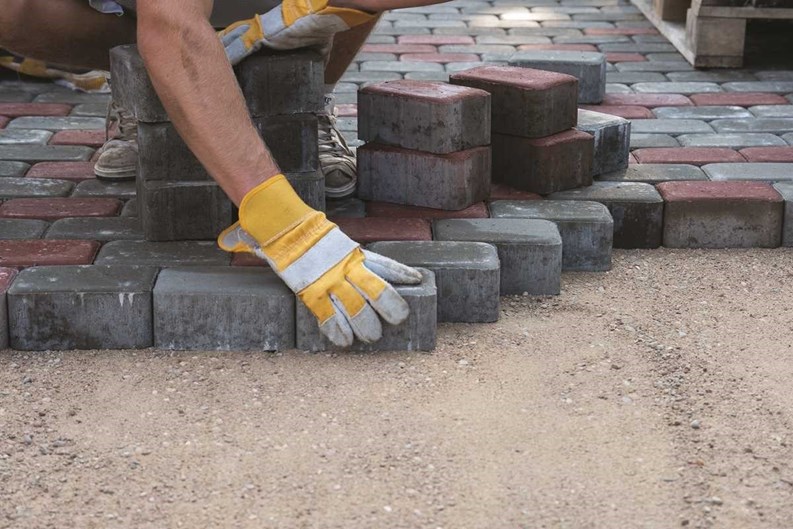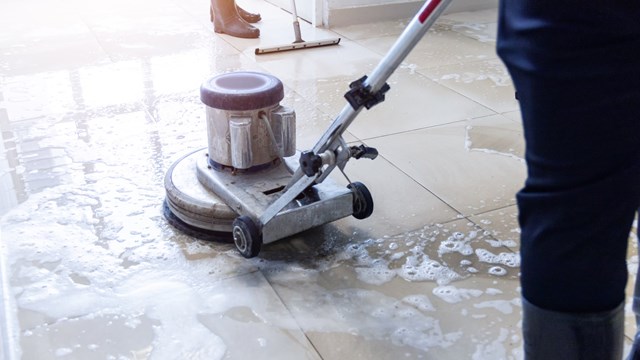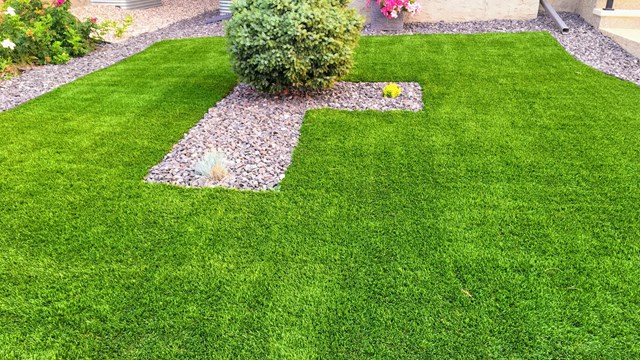The expansive main lodge at Wachusett Mountain Ski Area in North Central Massachusetts is surrounded with walkways, decks and terraces built in a variety of materials. Outside the bar area, wooden decks bridge a pond, connecting concrete steps in front with a new paver patio in the rear. An asphalt driveway wraps around the other side, edging an expanse of lawn that stretches to the foot of the ski slopes. With thousands of visitors tromping around in all four seasons, “hardscape” surfaces are a crucial component of the allover landscape plan that has to be attractive, durable and easy to maneuver.
“Whatever we’ve installed… it takes a beating,” states Wachusett Mountain Associates President Jeff Crowley. “It’s a high traffic situation, all around the base area,” he notes, adding that it’s not only the ski boots and utility vehicles and heavy equipment, but snow removal and ice-melt chemicals. And the challenge is year-around, with functions, festivals, major infrastructure and maintenance projects going on throughout the year. Over the past year, the ski lodge had an initial installation of 2,000 square feet, Crowley reports, “which will be about 6,000 square feet when it’s all done.” This includes a wide apron skirting the slope-facing side of the building which is fitted with radiant heat, to keep the surface snow and ice-free without chemicals or shoveling.
“We plan on expanding the pavers out to where the Ski School meets,” Crowley says. “It’s currently lawn there now but it becomes a mud pit every spring, and it’s a hassle to maintain,” he adds, and he’d recommend pavers for any high-traffic area outdoors.
Few condominium communities are likely to get the kind of heavy foot traffic that a facility like the ski area sees every year — but the concept of replacing expanses of high-maintenance turf or traditional hard surfaces like concrete is gaining appeal in residential settings for a variety of reasons these days.
Solving Surface Issues
Garrett Curtiss, project manager for Doug Curtiss Landscaping Designing, Inc., of Southborough, Massachusetts, reports that his firm has “done extensive replacement at a number of communities, switching from solid concrete or asphalt to pavers. One project was at Walker Meadow in Westborough… This 100-unit community had all concrete walkways. The board decided to rip out all the concrete and replace it with concrete pavers. The pavers today are manufactured better—they’ve come a long way. Where they used to lose aggregate on the surface, the new ones hold up better.”
They dominate large-scale and commercial installations, he says, for a lot of reasons—one of which is because the manufacturers “market them like crazy” so customers have become well aware of all the advantages. Brick and the many forms of natural stone are now more commonly seen in upscale, residential landscapes, he notes, to create a special effect. These more traditional materials are more costly and more labor-intensive, so clients looking for value, and bidding out their landscape projects, are leaning more than ever toward pavers. “While a job using pavers might be $15 per square foot, clay brick might be $20,” Curtiss notes.
Curtiss adds that clients have discovered the shortfalls in solid poured pavements. “Asphalt and concrete will eventually heave and crack. You’re going to see settling and heaving after 10 or 15 years, anywhere in New England. It has to be repaired by cutting out a section and re-pouring [material]. This results in a very visible patch job.”
“The advantage to pavers,” he continues, “is they can easily be replaced and repaired and look like new. When we install initially, we go down 12 inches instead of eight inches, which is the industry standard, so that setting bed doesn’t need to be replaced. On top of that is two inches of sand, then the pavers are laid on top.”
He explains that after the pavers are set on that multi-layered base, sand is applied over the whole top surface, to fill seams, and no mortar is used. “Another improvement is the use of polymeric sand, which has polymers in it and bonds more solidly,” Curtiss states. Polymeric sand, which has been in use for about a dozen years, is much finer and with the polymers in it, “it binds after watering, after it’s been dispersed into the seams. Even though it costs more,” he says, at about $30 for a cubic foot verses $25 per cubic yard for plain sand, it’s worth it because it works so much better.
Dominic Arangio is director of business development at Leahy Landscaping of Lynn, Massachusetts. With about 70 employees, Leahy handles every kind of landscaping project, including masons who can do hardscape projects. Arangio admits to favoring man-made pavers, as well. “We recommend them to customers as a replacement for [solid] concrete and asphalt. There’s such a wide range of colors, shapes and sizes… You can create limitless patterns and use color accents or edging. Even 20 years ago the choices were limited.”
He notes that New England weather is a major factor in choosing materials, and the paver system has really risen to the top for local projects. “Even something like stamped concrete, where the surface is molded to mimic natural stone,” he says, “may look like the real thing, but it works much better down south.” A popular version of stamped concrete looks like cobblestone, and can be seen on driveways and porticos at upscale hotels and restaurants. The “cobblestone” surface typically has a sealer that gives it a polished look. “We can use coatings on pavers,” Arangio explains, “to give it that sheen. Some customers ask for it, and it does offer some protection from fading.” He warns that the consumer versions of sealing materials offered at big-box retailers “don’t hold up as well” and notes that professional installers use products direct from manufacturers that are more durable.
If a hardscape project is large enough, storm water must be managed and drainage must be factored in. Arangio points out, “with major projects, architects and engineers are involved, and they design drainage systems into the plan.”
A New Approach to Drainage
In recent years, the U.S. Department of Environmental Protection as well as state and local agencies have been promoting low-impact development [LID] techniques for storm water management. LID techniques capture water on site, filter it through vegetation, and let it soak into the ground through use of open channels, rain barrels and cisterns, vegetated buffers and swales and rain gardens. The goal is to recharge the local water table instead of sending runoff through pipes and detention basins that ultimately empty into rivers.
Arangio describes a LID project his firm completed where “we had a field next to a building, that was to be turned into a parking lot using Eco-Stone® … These pavers are thick enough to support vehicles, while allowing storm water drainage through spaces between the interlocking pieces.” The manufacturer claims it infiltrates up to 100 percent of rainfall to recharge groundwater, reducing or eliminating peak runoff as well as pollutants. Eco-Stone is also billed as being snowplow-safe.
Some of these pervious hardscape designs include grasses or groundcover greenery allowed to grow between pavers, so that some lawn care maintenance becomes necessary.
Arangio adds that “Aqua-Bric® is another option where pavers are specified, if it’s an area that needs better drainage qualities, near coasts or shorelines.” The product is designed to form a stable surface that can accommodate pedestrians, wheelchairs and motor vehicles. It allows stormwater to drain through the pavement and infiltrate into the soil below. It can hold up to commonly-used de-icing salts as well as snow removal using shovels, snow blowers or snow plows. The cost is touted as being comparable to conventional poured pavement that would include catch basins, piping and retention basins.
But Arangio cautions, “The success of all these [LID] options depend on each specific situation… how heavy the foot or vehicle traffic is, local weather extremes, a staff that’s skilled in any special maintenance, and how to monitor that.”
Even though maintenance is minimal on paver constructions, Arangio notes, “Site managers do have to keep an eye out. The polymeric sand that fills the seams is very fine-grained and the polymer binding agent in it makes a strong seal that should prevent weed growth. We recommend checking it annually and spreading more of the sand when and where it’s needed.”
Jeff Souza, owner of Masonworks in Melrose, Massachusetts, agrees that interlocking pavers are hard to beat. “They’re really a big thing, at a fraction of the cost of natural stone. We find that customers now are asking for them by name. They are only good for flat surfaces… anything horizontal, and they are dry-laid with the polymeric sand in the seams to prevent germination and plant growth. While poured concrete still costs less at about $11 per square foot, and the paver installation can be $14 and up per square foot, including everything,” he notes, the high-end, customized look, easy replacement, non-slip surface and longevity of the product should qualify the extra cost, at developments which have made the investment.
While generations of New England residents may have devoted countless hours to moving stones out of their way to create plow-able fields and lush expanses of lawn, homeowners in communities are now enjoying that natural stone look — even if manufacturers are giving Mother Nature a boost in creating today’s popular surfaces.
Marie Auger is a freelance writer and a frequent contributor to New England Condominium.







Leave a Comment